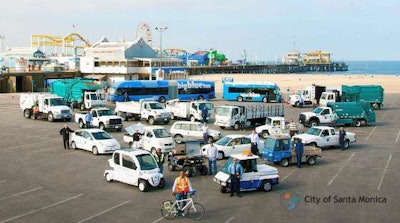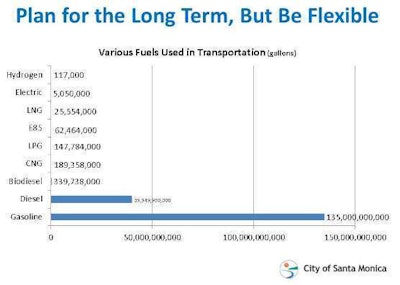
The City of Santa Monica, Calif. sits on the shores of the Pacific Ocean and is nestled in the shadows of Los Angeles.
It’s also in the grips of some of the tightest vehicle emission regulations in the United States.
To combat that, the municipality has invested heavily in alternative fuels.
“The city’s been able to place alternative fuel in most applications,” says Rick Sikes, Fleet Superintendent for the City of Santa Monica.
The city’s municipal fleet has about 800 pieces of equipment, and Sikes says nearly 85 percent is alternative fuel, which includes electric, propane, CNG, hydrogen and biodiesel-powered vehicles.
Before jumping into alternative fuel, Sikes says it’s important to prioritize and understand why you want to make the switch, which will help develop a policy.
He recommends identifying several reasons why you want to move away from oil.
For the City of Santa Monica, a coastal town and tourism heaven, the city decided going green was in its best interest to meet its fuel needs while limiting the impact on the environment.
The city is no stranger to alternative fuel, having adapted propane to its fleet in the 1980s. In the 90s, the city turned to electrics and bio-diesels and continued to invest as the century turned.
“The air we breathe today is cleaner than it was,” he says.
Sikes says Santa Monica’s policy objectives were to reduce conventional gas and diesel fossil fuel; reduce emissions; ensure new vehicle purchases provide best benefit; optimize fleet size; inventory and report fleet-wide GHG emission; and reduce the environmental impact of the vehicle fleet.
Where to start
Sikes says the first step in developing your fleet’s policy is to study what you already have by taking an accurate inventory of vehicles.
“Look for high total cost of ownership vehicles,” he says. “These can have the biggest impact with alternative fuel replacement.”

“But over the life of the vehicle, fuel costs will be substantially less,” he says.
The city has its own fueling stations and there is also a private station in the city.
It’s also important, Sikes says, to make a rational decision based on whether or not alternative fuels help you meet your objectives. He advises not to jump in headfirst in an effort just to displace fossil fuels.
“All fuels have issues. Some less than others,” he says. “There will probably not be a single fuel that displaces petroleum in transportation in our lifetime.”
Flexibility in the policy is another key.
Santa Monica’s original policy only addressed air quality and emissions. As gas and diesel engines improved, the benefits of going green became less obvious. “(Our policy) had to change as gas engines were more efficient,” he says.
And never be shy about asking for advise, Sikes says. Collaboration is important. Organizational leadership should communicate with vehicle operators and their management to explain the benefits of any changes in strategy and seek their feedback.
Seek out dealers, component and equipment providers, up-fitters and providers and speaking with other fleet managers and associations can help you avoid some pitfalls they may have found previously.
Organizations like Clean Cities and regulatory agencies can also help fleets find incentive money, Sikes says.









